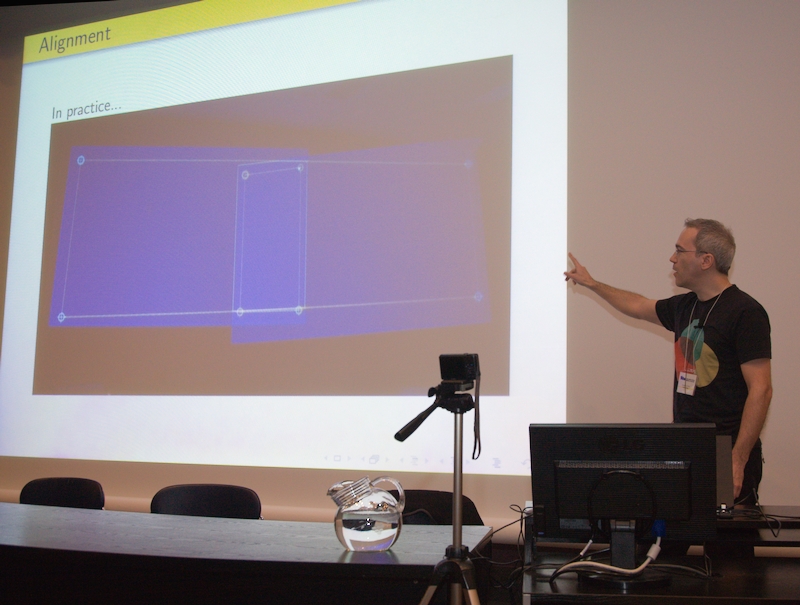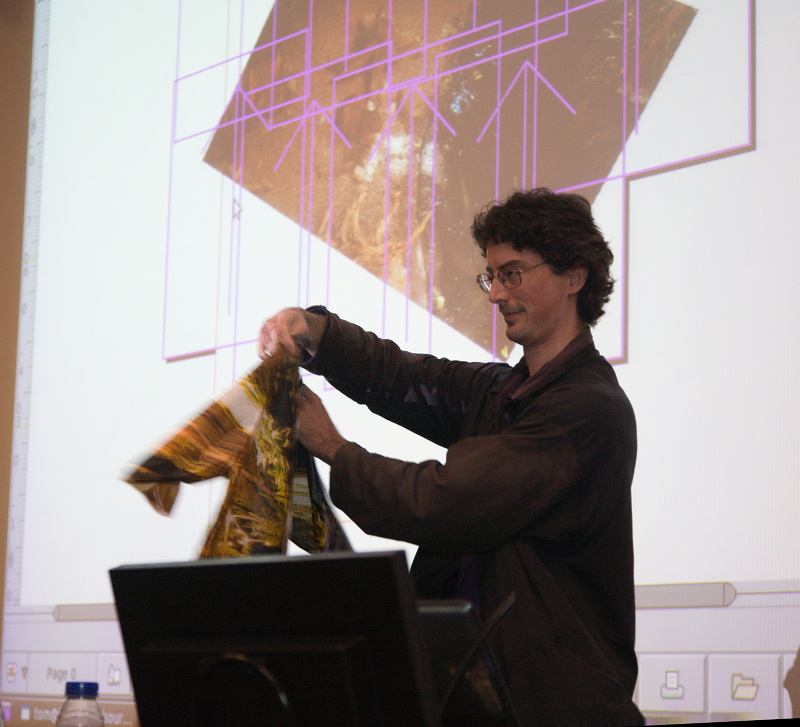Last week I was in Montreal for Libre Graphics Meeting (LGM), the annual summit of open source graphics developers (GIMP, Krita, Inkscape, Scribus, and others). Talk of LGM occasionally prompts head-shaking from those who think of it as a bit of a “mad scientist convention” — where crazy new technology debuts that won’t ever appear on the average desktop Linux machine. While there was certainly a healthy portion of zany demos this year, there were also plenty of enhancements that will make desktop computing tangibly better. Even if many of them started out in the “zany demo” column originally.
That’s What I Call “Scope”
For example, the Lighttwist project began in a research lab at the University of Montreal, working on stitching video displays together. In 2009, the project showed off a 360-degree panoramic video display that seamlessly blended the video output of seven high-definition projectors into a cylindrical display that you could stand right in the middle of. No matter where you put the projectors, the system could calibrate their overlap and merge them into a smooth, full-speed display for video or 3D. Pretty cool, but not very practical.
 This year, the Lighttwist team was back, but they were not showing off super-pricey immersive displays. Instead, Lighttwist has shrunk down into a simple-to-install plug-in for Compiz. Running the plug-in, you can aim two inexpensive “office” projectors (which are typically 4:3) at the wall, and merge them into a full HD display. Because Compiz works at the lowest level in the display manager stack, everything from games to video players can take advantage of the result. In 2009, the alignment process was complicated, relying on a sequence of special test-patterns that flew across the screens. Now all it takes is moving a “bullseye” on each screen until they overlap.
This year, the Lighttwist team was back, but they were not showing off super-pricey immersive displays. Instead, Lighttwist has shrunk down into a simple-to-install plug-in for Compiz. Running the plug-in, you can aim two inexpensive “office” projectors (which are typically 4:3) at the wall, and merge them into a full HD display. Because Compiz works at the lowest level in the display manager stack, everything from games to video players can take advantage of the result. In 2009, the alignment process was complicated, relying on a sequence of special test-patterns that flew across the screens. Now all it takes is moving a “bullseye” on each screen until they overlap.
If you’re a gaming nut or a home theater buff, this is something you can use now. Set up three or four projectors if you can afford them, or bypass 16:9 entirely and watch your cinematic classics on a 2.39:1 aspect ratio the way Cinemascope was intended to be seen. The maintainers even assured the audience that the code is easily portable to Mutter or any other display manager, for those who think Compiz is on the way out.
Set It and Forget It Color
A topic that comes up frequently at LGM is color management, which is important to creative professionals, but tends to make regular users’ eyes glaze over. Or, at least, the average user would like for it to work when printing out a digital photo, but is not interested in having to set it up manually (particularly if it is going to be a hassle).
On that front, the good news at LGM 2011 was Richard Hughes’ colord, a system daemon that does all the headache-inducing color management worry for you. Up until now, if you wanted to match colors between two monitors or a scanner and a printer, you had to go into the preferences of every application you might need to use, and set a bunch of configuration variables. With colord running, the applications can look up the proper settings themselves. Making colord work does require that the app code in support for it, but don’t expect that to take very long, either — Boudewijn Rempt was busy adding colord support to Krita mere minutes later.
Colord alone won’t make proper color support fully automatic — Hughes said that Mac OS X scores a 9 out of 10 on color management, Windows a 6 out of 10, and Linux a 1. But colord is a huge step forward. GTK+ is plotting color management integration at the toolkit level, and Kai-Uwe Behrmann is working on a framework by which the system can query the attached monitor(s) and automatically retrieve configuration settings. That is pretty much the end goal: a Linux desktop that makes all your images look right, electronically and in print, without you having to get involved at all.
The Interface That’s One Step Ahead of You
The GIMP image editor is a frequent topic at LGM, and also a frequent target of criticism from casual users. Usually that’s because GIMP is a densely-packed toolkit, and most casual users only want to do one or two small tasks with it — at which point they get overwhelmed or lost in the interface. University of Waterloo’s Michael Terry is a Human Computer Interaction (HCI) researcher whose students often poke and prod GIMP.
This year they introduced AdaptableGIMP, a derivative of the image editor that overlays a task-oriented interface on top of the raw GIMP tool suite. A search box lets you type in what you want to do (such as “draw a border around a photo”), then pops up a sorted list of tasks that match your keywords. Each one you click on reveals a list of the steps you need to accomplish, selecting the right tool and setting for each step. All you have to do is follow the guide. If any of it is unclear, you can click on a “more info” link to pop up a more detailed description of each step and how it fits into the process. And if you’re concerned that the tasks the AdaptableGIMP team cooked up aren’t going to meet your needs, don’t be: they ran Google queries for the most searched-after GIMP how-to topics, and used that as their basis.
And More….
Those weren’t the only practical talks at this year’s LGM, but they give you an idea of what the content was like. Two staffers from the popular image-sharing service deviantArt were on-hand to explain their new uploading and querying API (to which they gave LGM developers early access), so you should start seeing built-in deviantArt uploading in your favorite graphics app any day now. Louis Desjardins demonstrated how to do spot color printing with Scribus (which suggested a change to make it even easier in the next release), and Nicolas Robidoux showed off several image re-sizing algorithms he has developed (which you should see shortly in various image-editing apps). Last but not least, Web teams debuted relaunched versions of both the Open Clip Art Library and Open Font Library, both of which have been reworked to be simpler to use.
That isn’t to say that LGM has gone completely “practical” or dull, however. There were plenty of off-the-wall surprises on display as well. Alexander Quessy showed off ToonLoop, a live-video DJing and animation tool that lets you loop and manipulate a Webcam in real time (with the keyboard, a MIDI device, or over the network). GIMP’s Øyvind “pippin” Kolås demonstrated an OpenGL-based presentation app that he and his colleagues at Intel wrote for their own presentations. Called Pinpoint, it supports any type of media you can throw at it, but it uses only simple plain-text files as its document format.
 Cartoonist Tom Lechner brought down the house in 2010 with Laidout, app that can split up an image into any flat-paper layout you can imagine — including unrolling it from a 3-D polyhedron. That means you can print Laidout’s output, flat, on any run-of-the-mill printer, and fold the result into the 3-D polyhedron shape; no complex math required on your part. His 2011 talk did not disappoint either, showcasing Laidout’s new ability to manipulate a document into accordion-like booklets and folded patterns, or wrap it all the way around a random physical object, such as a t-shirt. It can even respond to multiple system mice at the same time, just for kicks.
Cartoonist Tom Lechner brought down the house in 2010 with Laidout, app that can split up an image into any flat-paper layout you can imagine — including unrolling it from a 3-D polyhedron. That means you can print Laidout’s output, flat, on any run-of-the-mill printer, and fold the result into the 3-D polyhedron shape; no complex math required on your part. His 2011 talk did not disappoint either, showcasing Laidout’s new ability to manipulate a document into accordion-like booklets and folded patterns, or wrap it all the way around a random physical object, such as a t-shirt. It can even respond to multiple system mice at the same time, just for kicks.
That’s what makes LGM fun; there is “serious” practical work mingled right in with projects so far outside the box that you might even forget the box is still there. Who knows when you’re going to need to print a 3-D polyhedron out on paper or make a design that covers every square inch of a t-shirt without distortion. Just two years ago, Lighttwist looked like something only an “immersive computing” laboratory with deep pockets could use, and now it’s a simple Compiz plug-in anyone can use to stitch a wide-screen projection together with a couple of mouse clicks. Time will tell.





